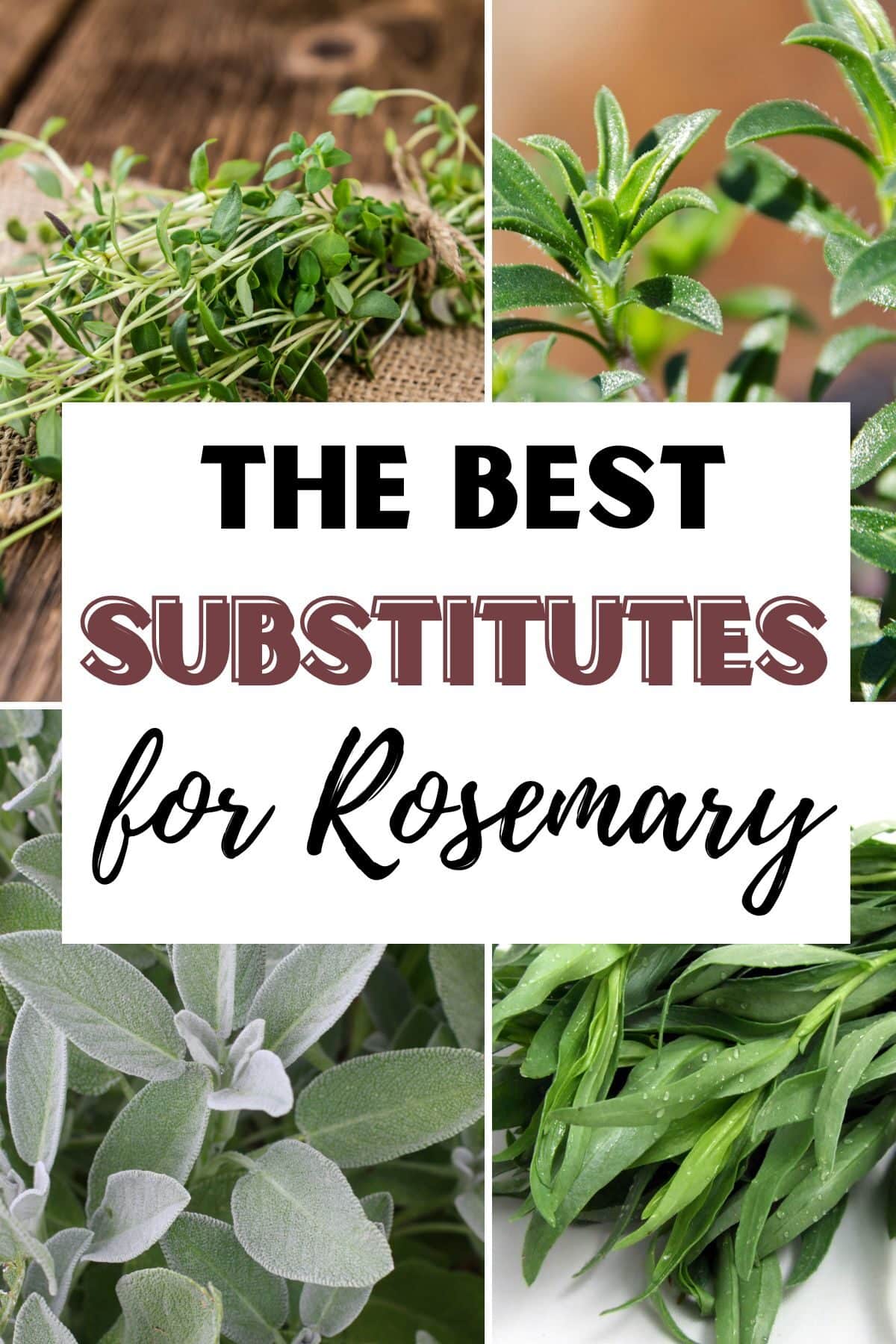Rosemary has long been cherished for its distinct aroma and flavor that adds a delightful touch to countless culinary creations.
But what if you find yourself without this beloved herb on hand?
Fear not, for there are numerous substitutes that can easily step in to fulfill your seasoning needs.
From the earthy undertones of thyme to the robustness of sage, there’s a rosemary substitute for every discerning palate.
So whether you’re a seasoned cook or an adventurous beginner, join us as we uncover the fascinating world of rosemary alternatives and unlock a world of savory delights.
rosemary substitute
A good substitute for rosemary is thyme, sage, marjoram, oregano, Italian seasoning, bay leaf, or peppermint.
These herbs provide similar flavors and can be used in place of rosemary in savory dishes such as potatoes, sauces, meat dishes, and breads.
If using dried rosemary as a substitute, use 1 teaspoon for every 1 tablespoon of fresh rosemary.
Popular spice blends that pair well with rosemary include herbs de Provence, which contains rosemary, marjoram, oregano, savory, and thyme.
Key Points:
- Thyme, sage, marjoram, oregano, Italian seasoning, bay leaf, or peppermint can be used as substitutes for rosemary.
- These substitute herbs provide similar flavors and can be used in savory dishes.
- Dried rosemary can be used as a substitute, using 1 teaspoon for every 1 tablespoon of fresh rosemary.
- Herb blends such as herbs de Provence are a popular pairing with rosemary.
- Rosemary substitutes can be used in dishes like potatoes, sauces, meat dishes, and breads.
- These substitute herbs can provide similar flavors to rosemary.
rosemary substitute – Watch Video
💡
Pro Tips:
1. Rosemary is commonly used in Mediterranean cuisine, but did you know that you can substitute it with an herb called savory? Savory has a similar flavor profile and can be a great alternative in dishes like roasted vegetables and grilled meats.
2. In some ancient cultures, rosemary was believed to have memory-enhancing properties. Students would often wear rosemary garlands during exams to stimulate their memory and concentration.
3. If you ever find yourself out of rosemary while baking, you can replace it with dried marjoram. Marjoram has a slightly milder flavor but still adds a pleasant herbal note to your baked goods.
4. Rosemary has been used for centuries in traditional medicine to relieve headaches and migraines. Historically, people would inhale the scent of rosemary oil or make a tea from its leaves to alleviate the pain.
5. In folklore, rosemary was associated with protection and was often used in ancient rituals to ward off evil spirits. It was believed that hanging rosemary sprigs around the house or carrying them could bring good luck and provide protection against negativity.
Rosemary: A Piney Aromatic Herb
Rosemary, a herb known for its piney flavor and intoxicating aroma, has been a staple in kitchens around the world for centuries. This versatile herb adds depth and richness to a variety of savory dishes, making it a favorite among chefs and home cooks alike. With its distinct taste and fragrance, rosemary elevates the flavors of potatoes, sauces, meat dishes, and breads. Whether you’re a seasoned chef or an aspiring home cook, understanding the versatility and substitutes for rosemary is crucial in enhancing your culinary creations.
- Rosemary is a herb with a piney flavor and intoxicating aroma.
- It is widely used in kitchens around the world.
- Rosemary adds depth and richness to savory dishes.
- It enhances the flavors of potatoes, sauces, meat dishes, and breads.
“Understanding the versatility and substitutes for rosemary is crucial in enhancing your culinary creations.”
Versatile Uses of Rosemary in Savory Dishes
When it comes to using rosemary in your cooking, the possibilities are endless. Its robust flavor profile pairs well with a wide range of savory dishes, bringing a unique and delightful taste to each creation.
For example, adding rosemary to roasted potatoes can elevate the flavors and create a mouth-watering side dish. In sauces, rosemary adds a burst of aroma, creating a memorable dining experience.
Meat dishes paired with rosemary take on a whole new level of depth and richness, making every bite a culinary adventure.
Finally, incorporating rosemary into bread recipes infuses the dough with its aromatic essence, resulting in delightful, flavorful loaves.
Substitutes for Rosemary: Thyme, Sage, Marjoram, and More
When rosemary is not readily available, there are several substitutes that can be used in its place. Thyme is an ideal alternative, as it has an earthy and slightly minty flavor. It pairs well with roasted meats, vegetables, and sauces. Another suitable substitute is sage, which has a slightly peppery and camphor-like taste. It can be used in dishes like roasted chicken or stuffing. Marjoram brings a unique twist to dishes that traditionally feature rosemary, thanks to its citrusy undertones. Oregano, another herb from the mint family, can also be used as a substitute, especially in Italian-inspired recipes. If you have Italian seasoning, a blend of various herbs including oregano, rosemary, and thyme, it can be a versatile alternative for seasoning dishes. While bay leaf and peppermint do not share the exact flavor profile of rosemary, they can still add interesting dimensions to dishes typically seasoned with rosemary.
Conversion: Fresh Rosemary to Dried Rosemary
Understanding the conversion between fresh and dried rosemary is essential when following a recipe that calls for specific measurements. Generally, 1 tablespoon of fresh rosemary can be substituted with 1 teaspoon of dried rosemary. Keep in mind that the intensity of the flavor may vary, so it’s always best to adjust the amount based on your personal taste preference.
- 1 tablespoon fresh rosemary = 1 teaspoon dried rosemary
- Flavors may vary, so adjust according to personal taste preference.
Spice Blends that Complement Rosemary
To enhance the flavors of rosemary even further, incorporating it into spice blends can be a fantastic option. One popular blend that goes hand in hand with rosemary is herbs de Provence. This blend traditionally combines rosemary, marjoram, oregano, savory, and thyme, creating a symphony of aromatic herbs that perfectly complement each other.
The herbs de Provence blend can be used in a variety of dishes, including:
- Roasted vegetables
- Grilled meats
- Stews
Adding the herbs de Provence blend to these dishes will add a delightful Mediterranean touch to your creations.
“Incorporating rosemary into spice blends like herbs de Provence can enhance the flavors and provide a delightful Mediterranean touch to dishes.”
Herbs De Provence: A Perfect Blend with Rosemary
Herbs de Provence, a culinary blend rooted in the Provence region of France, captures the essence of the Mediterranean with its combination of aromatic herbs. This versatile blend can bring out the best in rosemary, harmonizing with its piney flavor and creating a delightful flavor profile. Whether you’re preparing a classic ratatouille or a simple roasted chicken, incorporating herbs de Provence can elevate your dish to new heights of culinary perfection.
- The blend of aromatic herbs in Herbs de Provence captures the essence of the Mediterranean.
- Incorporating herbs de Provence can enhance the flavor of rosemary, giving it a harmonious and delightful taste.
- It is a versatile blend that is perfect for both classic recipes like ratatouille and simple dishes like roasted chicken.
“Herbs de Provence adds a touch of Mediterranean magic to any dish.”
Rosemary in Potatoes: Enhancing Flavors
One of the most popular uses of rosemary in cooking is enhancing the flavors of potatoes. Simply adding rosemary to roasted or mashed potatoes can take the dish from ordinary to extraordinary. The piney undertones of rosemary bring a unique and delightful flavor, complementing the earthiness of the potatoes. Whether you’re making French fries, potato wedges, or a creamy potato gratin, the addition of rosemary can create a memorable and mouth-watering dish.
Rosemary in Sauces: A Burst of Aroma
Sauces are another culinary arena where rosemary shines brightly. Whether you’re making a rich tomato-based pasta sauce or a savory gravy, adding rosemary can bring a burst of aroma that tantalizes the senses. The herb’s robust flavor seamlessly blends with the other ingredients, creating a harmonious symphony of tastes. Consider incorporating rosemary into your next sauce creation to add a touch of sophistication and depth to your culinary masterpiece.
Rosemary in Meat Dishes: Adding Depth and Richness
Rosemary and meat are a perfect culinary combination. Adding rosemary to your roasts, steaks, or grilled chicken can elevate your meat dish to a whole new level. The herb’s piney flavor brings out the rich and deep taste of the meat, creating a flavorful masterpiece. For an even more impressive result, consider infusing your marinades or rubs with rosemary. This simple addition will amaze your guests and showcase your culinary skills.
Rosemary in Breads: Aromatic and Delightful
Incorporating rosemary into bread recipes can take your homemade loaves to new heights of aromatic delight. From focaccia to dinner rolls, adding rosemary to the dough infuses it with an irresistible fragrance. As the bread bakes, the herb’s essence spreads throughout the kitchen, creating an enticing atmosphere. The combination of the herb’s distinctive flavor and the warmth of freshly baked bread is a sensory experience that leaves a lasting impression on anyone lucky enough to taste it.
- Rosemary is a versatile herb that adds a piney flavor and delightful aroma to a variety of savory dishes.
- When rosemary is not available, substitutes such as thyme, sage, marjoram, and oregano can serve as suitable alternatives.
- Understanding the conversion between fresh and dried rosemary is crucial when following recipes.
- Incorporating rosemary into spice blends, particularly herbs de Provence, can enhance its flavors further.
- Whether you’re enhancing the flavors of potatoes, adding depth to sauces, enriching meat dishes, or creating aromatic breads, rosemary is a culinary powerhouse that can elevate your cooking to a whole new level.
💡
You may need to know these questions about rosemary substitute
What herb can I use instead of rosemary?
If you are looking for a herb to replace rosemary, thyme is a great option. It can be used fresh or dried and offers a more subtle flavor. Another alternative is sage, which has a similar pine-like taste to rosemary. Additionally, dried marjoram or savory can be used as substitutes for rosemary.
What is a substitute for 2 tablespoons of fresh rosemary?
Thyme. Thyme is a suitable substitute for fresh rosemary due to its comparable earthy and aromatic qualities. Like rosemary, thyme adds depth and flavor to dishes. Use fresh thyme in a 2:1 ratio for fresh rosemary, starting with 1 tablespoon and adjusting to your preference for a herbaceous and savory taste.
Is parsley a good substitute for rosemary?
While parsley can provide a similar refreshing flavor, it may not fully replicate the distinct taste of rosemary. However, in seafood dishes, fresh parsley can still act as a satisfactory substitute for rosemary, adding a bright flavor to complement the seafood. It is important to note that for optimum taste, fresh parsley should be added towards the end of the dish rather than being subjected to prolonged cooking.
What can I substitute for 1 teaspoon of fresh rosemary?
If you don’t have fresh rosemary on hand, another alternative to consider is dried thyme. With its earthy and slightly minty flavor, dried thyme can provide a similar aromatic depth to your dish. However, remember that thyme can be quite strong, so start by using only ½ teaspoon to replace 1 teaspoon of fresh rosemary. Adjust the amount to taste, keeping in mind that less might be needed if you prefer a more subtle herb flavor.
Reference source
https://www.thespicehouse.com/blogs/news/rosemary-substitute
https://www.acouplecooks.com/best-substitute-for-rosemary/
https://food52.com/blog/24678-best-thyme-substitutes
https://www.theharvestkitchen.com/rosemary-substitute/



